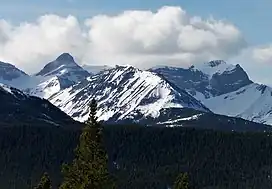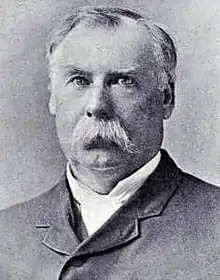| Mount McLaren | |
|---|---|
 | |
| Highest point | |
| Elevation | 2,301 m (7,549 ft)[1][2] |
| Prominence | 220 m (722 ft)[1] |
| Parent peak | Mount Ptolemy (2,813 m)[1] |
| Isolation | 1.38 km (0.86 mi)[1] |
| Listing | Mountains of Alberta |
| Coordinates | 49°34′59″N 114°34′05″W / 49.58306°N 114.56806°W[3] |
| Naming | |
| Etymology | Peter McLaren |
| Geography | |
 Mount McLaren Location of Mount McLaren in Alberta  Mount McLaren Mount McLaren (Canada) | |
| Location | Castle Wildland Provincial Park Alberta, Canada |
| Parent range | Flathead Range[4] Canadian Rockies |
| Topo map | NTS 82G10 Crowsnest[3] |
| Geology | |
| Mountain type | Fault block |
| Type of rock | Limestone[5] |
| Climbing | |
| Easiest route | Scrambling via SW Ridge[5] |
Mount McLaren is a 2,301-metre (7,549-foot) mountain summit located in Alberta, Canada.
Description
Mount McLaren is situated six kilometers southwest of the town of Coleman in the Crowsnest Pass area and can be seen from the Crowsnest Highway (Highway 3).[2] It is part of the Flathead Range which is a subset of the Canadian Rockies. The peak is set two kilometers east of the Continental Divide, in Castle Wildland Provincial Park. Precipitation runoff from the mountain drains into Star and North York creeks which are tributaries of the nearby Crowsnest River. Topographic relief is significant as the summit rises over 945 meters (3,100 feet) above the river in 5 kilometers (3.1 miles). Chinook Peak is 3.0 km (1.9 mi) to the west of Mt. McLaren and the nearest higher neighbor is Mount Parrish, 1.4 km (0.87 mi) to the southwest.[1]
History

Mount McLaren is named after Peter McLaren (1833–1919), a Canadian politician and Senator from Perth, Ontario.[6] Senator Peter McLaren was involved in the timber trade and operated a sawmill on Mill Creek (west of Pincher Creek) which provided railroad ties for the construction of the Crowsnest Pass Railway in 1897 and 1898. His loggers hewed the trees ahead of track layers. The mountain's toponym was officially adopted March 15, 1962, by the Geographical Names Board of Canada.[3]
On January 19, 1946, a Royal Canadian Air Force DC-3 struck Mount Ptolemy and crashed into the North York Creek valley below Mount McLaren.[2] All seven crewmembers perished in the accident. Some wreckage of the aircraft is still present.
Geology
Mount McLaren is composed of limestone which is a sedimentary rock laid down during the Precambrian to Jurassic periods. Formed in shallow seas, this sedimentary rock was pushed east and over the top of younger Cretaceous period rock during the Laramide orogeny.[7]
Climate
Based on the Köppen climate classification, Mount McLaren has an alpine subarctic climate with cold, snowy winters, and mild summers.[8] Temperatures can drop below −20 °C with wind chill factors below −30 °C.
Gallery
See also
References
- 1 2 3 4 5 "Mount McLaren, Peakvisor.com". Retrieved November 2, 2022.
- 1 2 3 "Mount McLaren". cdnrockiesdatabases.ca. Retrieved 2022-11-02.
- 1 2 3 "Mount McLaren". Geographical Names Data Base. Natural Resources Canada. Retrieved 2022-11-02.
- ↑ "Flathead Range". Geographical Names Data Base. Natural Resources Canada. Retrieved 2022-11-02.
- 1 2 Andrew Nugara (2014), More Scrambles in the Canadian Rockies Second Edition, Rocky Mountain Books, ISBN 9781771600170, p. 184
- ↑ Dave Birrell (2000), 50 Roadside Panoramas in the Canadian Rockies, Rocky Mountain Books, ISBN 9780921102656, p. 139
- ↑ Gadd, Ben (2008), Geology of the Rocky Mountains and Columbias
- ↑ Peel, M. C.; Finlayson, B. L.; McMahon, T. A. (2007). "Updated world map of the Köppen−Geiger climate classification". Hydrol. Earth Syst. Sci. 11: 1633–1644. ISSN 1027-5606.
External links
- Mount McLaren: weather forecast



